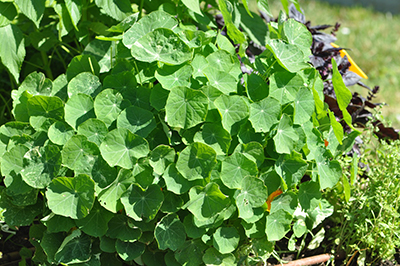Tropaeolum (Tropaeolaceae)


| ENG | Nasturvcia |
| SK | Kapucínka |
| CZ | Lichořeřišnice vťší |
| PL | Nasturcja większa |
| HU | Kerti sarkantyúka |
Using
All parts of Tropaeolum majus sre edible. The flower has most of ten been consumed. Flower is used for especially ornamental salad ingredient. The taste is slightly peppery, reminiscent of watercress. Flowers contain about 130 mg vitamin C per 100 grams and up to 45 mg of lutein per 100grams of fresh matter. The unripe seed pods can be used into spiced vinegar and used in place of capers. Nasturtiums are used in herbal medicine for their antiseptic, expectorant qualities, for chest cold. It helps the formation of new blood cells, cures urinary and respiratory tract infections. The peppery taste of nasturtium is due to the chemical component glucosynolates, which are also present in mustard oil. The aroma of the leaves, stems and flowers is pungent
| I. | II. | III. | IV. | V. | VI. | VII. | VIII. | IX. | X. | XI. | XII. | |||||||||||||
| Sowing | ||||||||||||||||||||||||
| Planting | ||||||||||||||||||||||||
| Harvest | ||||||||||||||||||||||||
Botanical description and occurrence:
The genus Tropaeolum, native to South and Central America, includes several popular garden plants. The most commonly grown are T. Majus, T. Peregrinum and T. Speciosum. The species T. Polyphyllum from Chille has perennial roots and can survive the winter underground at altitudes of 3,300 m. Tropaeolum majus grow in moist, well drained, lean soil in full sun. Propagation: Seed sowing is the best indoors in early spring, or in mid spring in situ. The plant has long trailing or climbing (up to 2 m high) succulent stems. The leaves are simple and have long petioles. The cultivars of this plant show variation mainly in flower color and number of petals.
Why to have the plant in your garden:
These decorative annuals are suitable for garden edges, herb gardens, covering banks, hanging baskets and other containers. Leaves and flowers can be eaten in salads; unripe seeds and flower buds are used pickled and served as a capers. Edible flowers are suitable for decorating various dishes, salads, cakes, ice cream and drinks.
Text:
prof. Ing. Magdaléna Valšíková, PhD., SUA, Nitra, Slovak Republic
Photo:
Dr. Jan Mezey, SUA, Nitra, Slovak Republic
Links to scientific articles (if it is possible):
http://www.finegardening.com/indian-cress-tropaeolum-majus-jewel-africa

